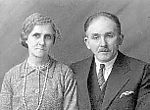1921 saw the opening of a new cinema in the Black Country; the "Limelight" at Harts Hill. This cinema was a plain brick building tucked away behind a row of houses on Vine Street. John Henry Revill, the builder and proprietor was an engineer at the local firm of Cartwright and Paddock, he built this cinema next to his house in his spare time at a cost of just under ?130.
The Limelight was an unpretentious cinema, only 30ft by 15ft, with a wooden roof, concrete floor and a screen made from two asbestos sheets joined together. The auditorium could seat up to 103 people on the plain wooden benches, also made by the resourceful Mr Revill. Crammed into the tiny 5ft square operating room were two newly purchased second-hand projectors, a Dreadnought Bioscope that had cost ?20, and a vintage 1912 model Ernemann Bioscope that was purchased for ?30. The light source for these antique projectors was the old fashioned method of burning lime pastilles with oxygen to produce a bright white light.
Mr Revill operated the projectors himself, assisted by his nephew, Leslie Ball. In fact the whole venture was very much a family affair. All the Limelight's customers were locals; John Revill printed his own posters and his wife Mary distributed these to the nearby shops for display. Several Harts Hill people today still retain vivid memories of queuing at the cinema gates on Saturday mornings waiting for them to open so that they could race down the alley and be the first to buy their penny tickets for the children's matinee.
For the first few weeks the Limelight Cinema earned John Revill just over ?2 a week on top of the wage from his day job. He must have felt encouraged to invest further in the cinema because in 1926 he decided to extend it. This extension consisted of an extra 16 feet of brickwork which enabled him to install 18 tip-up cinema seats and two gas radiators for the added luxury of warmth for his customers. The projection room was also made slightly more spacious which was just as well because around this time Mr Revill traded his original projectors for two "new" Kamm projectors, a Motiograph and an Ernemann.
Throughout 1928 John Revill continued to make a profit out of the regular programmes of Charlie Chaplin comedies, feature length Westerns, and cliff-hanging serials, but in 1929 everything changed. From the beginning of that year expenditure was exceeding income by over ?4 every month, until June when losses were over ?12. After a disastrous first week in July John Revill closed his and his cinema. He must have realised that he could not compete with the luxury cinemas showing the new talking pictures that had recently opened in the nearby towns of Dudley and Brierley Hill.
When the new owners of the property, Rounds Transport, approached the Black Country Museum in 1993 seeking a home for the Limelight and all its associated equipment the Museum jumped at the chance to re-create this unique piece of Black Country History.
Rollover the captions in the box to see the available images in thumbnail format, click the caption to see the full-size image
| Reference: | 131 |
| Keywords: | Revill Vine Street Cartwright Projector Charlie Chaplin Hardy MCOL BCLM |
| Archive Ref: | A L's synopsis of Cinema Photo from Project and Spec File |
| Updated: | 11/9/2001 15:05:31 |



